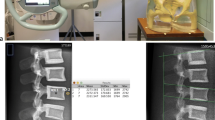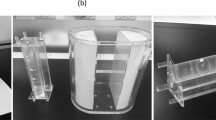Abstract
The effect of various air gaps on computed radiographic musculoskeletal images was investigated using a knee phantom. Scatter to primary radiation ratios were measured using the beam stop method at air gaps ranging from 0 to 30 in. (0-762-mm). Bony trabecular sharpness, line pair resolution, quantum mottle and visualization of low-contrast beads in the soft tissues were evaluated. A significant reduction of scatter to primary radiation ratio, from a value of almost 1 at table top to about 0.4 at 10-in. (254-mm) air gap and about 0.2 at 25-in. (635-mm) air gap placement of the computed radiography (CR) imaging plate, was obtained. A progressive improvement in bony trabecular sharpness and line pair resolution, compared with the table top and Bucky images was observed on 10-in. (254-mm) through 25-in. (635-mm) air gap images. Sharpness of the bony trabeculae and line pair resolution were best on the 25-in. (635-mm) air gap images. The skin entrance radiation dose does not have to be increased for air gap digital radiography. The radiographic noise or quantum mottle is highest on the Bucky image, higher on air gap images and minimal on the table top images, despite a high scatter to primary radiation ratio at the table top. The lower quantum mottle on the table top images allowed for maximal visualization of low contrast densities in the soft tissues. Air gap radiography further improves musculoskeletal computed imaging by reducing the scatter to primary radiation ratio without an increase in the skin entrance dose. For significant reduction of the scatter to primary radiation ratio and best evaluation of line pair spatial resolution and bony trabeculae, a 25-in. (635-mm) air gap with digital radiography would be optimal. For evaluation of low contrast densities in the soft tissues, table top placement would be the technique of choice.
Similar content being viewed by others
References
Sorenson JA, Nelson JA, Niklason LT, Jacobsen SC (1980) Rotating disk device for slit radiography of the chest. Radiology 134: 227–231
Michel M, Ter-Pogossian (1969) The physical aspects of diagnostic radiology, Harper & Row, New York
Landes JR, Koch GG (1974) The measurement of observer agreement for categorical data. Biometrics 33: 159–174
Tucker DM, Souto M, Barnes GT (1993) Scatter in computed radiography. Radiology 188: 271–274
Kuhns LR, Kottamasu SR (1995) Pediatric air-gap chest digital imaging: an experimental study. Pediatr Radiol 25: S99-S201
Neitzel U (1992) Grids or air gaps for scatter reduction in digital radiography: a model calculation. Med Phys 19: 475–481
Murphey MD, Bramble JM, Cook LT, Martin NL, Dwyer SJ (1990) Nondisplaced fractures: spatial resolution requirements for detection with digital skeletal imaging. Radiology 174: 865–870
Wegryn SA (1990) Comparison of digital and conventional musculoskeletal radiography: an observer performance study. Radiology 175: 223–228
Murphey MD (1989) Digital skeletal radiography: spatial resolution requirements for detection of subperiosteal resorption. AJR 152: 541–546
Richmond BJ, Powers C, Piraino DW, Freed H, Meziane MA, Hale JC, Schluchter MD, Schils J, Gragg LA (1992) Diagnostic efficacy of digitized images vs. plain films: a study of the joints of the fingers. AJR 158: 437–441
Wilson AJ (1991) Photostimulable phosphor digital radiography of the extremities: diagnostic accuracy compared with conventional radiography. AJR 157: 533–538
Murphey MD, Quale JL, Martin NL, Bramble JM, Cook LT, Dwyer SJ III (1992) Computed radiography in musculoskeletal imaging: state of the art. AJR 158: 1071–1080
Author information
Authors and Affiliations
Rights and permissions
About this article
Cite this article
Kottamasu, S.R., Kuhns, L.R. Musculoskeletal computed radiography in children: scatter reduction and improvement in bony trabecular sharpness using air gap placement of the imaging plate. Pediatr Radiol 27, 119–123 (1997). https://doi.org/10.1007/s002470050081
Received:
Accepted:
Issue Date:
DOI: https://doi.org/10.1007/s002470050081




